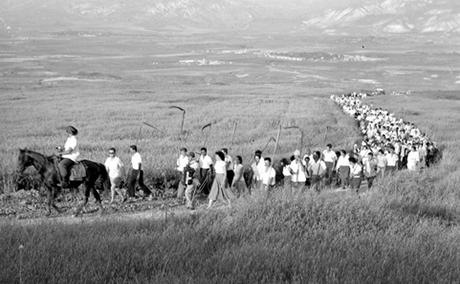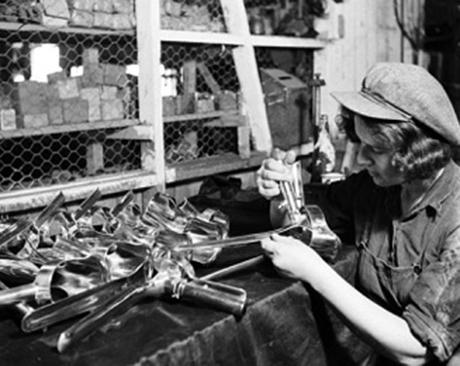Beginning in 1963, hundreds of aging women who lived in elderly homes in central Israel, some of whom were bed-bound, were asked to urinate into mobile containers, and donate their urine towards the Israeli struggle against infertility. Every day, the postmenopausal urine was collected with the help of female caretakers, and then, a different female worker, hired especially for the project, removed any traces of odor. The urine was driven in big containers to a local pharmaceutical company, where a kaolin cake absorbed its liquids. Then, in the form of powder, it was sent to the Italian pharmaceutical company Serono in Rome. At Serono, which was then under partial ownership of the Vatican, and already experienced in receiving doses of urine from old Italian nuns, sex hormones were “purified” from the powder, and made into a highly successful fertility drug—the first to induce ovulation—named Pergonal.

Fig. 2: Excerpt from a promotional film on fertility drugs produced by the Italian pharmaceutical company Serono, demonstrating the early postmenopausal urine collection campaign. Date unknown. Source: Merck “Corporate History” Archives/Serono Collection, Darmstadt.
We tend to regard urine as a useless substance, and have developed ways to jettison it from everyday life. However, like many other types of bodily materials that we consider to be waste, urine has been remarkably important. As part of my current research project, entitled “Barren Structures,” I examine the role of bodily wastes in scientific practices, with particular interest in when and how worthless matter becomes valuable. As part of this project, I take a close look at the emergence of urine as the basis of fertility research and treatments. I track the process through which urine was chosen to solve specific problems of the European settlement project in Palestine, and map the ways in which it connected distant places, institutions, people, and animals, and fostered new relationships among them.
Despite our modern public blindspot regarding the value of bodily waste, urine has long been useful in worlds of knowledge and practice such as medicine and agriculture. Many alchemists attempted to turn it into gold by distillation—discovering phosphate instead, which as fertilizer ultimately transformed agricultural production around the world. It has been used as a disinfectant, to clean leather and smooth wool, and, when consumed by its producer, as a solution for skin problems and other ailments—it is a practice known as “urine therapy.” In the realm of uroscopy, a highly important diagnostic method in Europe in the high middle ages, urine was considered to hold secret knowledge about human and animal bodies; this knowledge is now revealed through urinalysis. In the early twentieth century, with the emergence of the study of hormones, urine played a particularly important role, as it revolutionized reproduction and enabled the formation of strong bonds between science and industry.
In the early days of endocrinology, upon the realization that hormone-based fertility treatments can be mass-produced, various organs—pituitary glands, ovaries, testes, and placentas—became resources for the extractions of sex hormones. Searching for sex hormones in tissues dominated this field for a while. However, urine soon came to replace the tissues, following the discovery in the 1920s that the urine of pregnant women and mares, and a decade later that urine of postmenopausal women, were all rich in sex hormones. Urine was both cheap and endlessly available for the production of fertility drugs. Pharmaceutical companies expanded as many thousands of people used hormone-based drugs, and sent samples of their own urine in order to test their possibilities of impregnation. This explosion of market and industry was made possible by tightening connections between those companies and researchers at the lab; unlikely alliances were created as human and equine urine intimately connected them to farms, clinics, and to the endocrinal laboratory.
Moving urine around relied on and created diverse infrastructures. Public transportation companies and the mail system joined hands in the search for urine donors, and transporting individual human and animal samples for examination. Pharmaceutical companies and scientists had to collaborate in establishing a mechanism for urine manipulation: after tracking potential donors in farms, hospitals, elderly homes, or monasteries, they had to collect urine and pay donors (or their owners), contain and manage the smell, transport it, maintain its purity by avoiding mixture, analyze, purify, and standardize, ultimately making urine into drug to compete in an ever-growing market. Urine had to become invisible and odorless in order to become a potential cure.

Fig. 3: Poster prepared for the celebration of Passover in the cowshed of Kibbutz Mizra, 1947, depicting the ideal of fertile life in Palestine. It reads: “Our heads will be filled and filled with dew. The blessing of seed/sperm will not betray.” Source: Toshek: Avraham Amarant. Tel-Aviv: Sifriyat Poalim, 1993.
In Palestine in the early twentieth century, where a multispecies European settlement project confronted the challenges of Middle Eastern environment and climate, infertility emerged as a grave problem to both humans and other animals. Many cows, sheep, as well as women, suffered from infertility and miscarriages. The greater the threat posed by infertility to the survival and growth of the settling population, the greater was the tendency to search for solutions in bodily waste. In these circumstances, the establishment of a community of fertility experts from the mid-1930s was interconnected with the circulation of urine: the urine of mares and women, already considered useful for the creation of drugs and markets, hence became central to the settlement efforts. The frequency of its movement between the farm, the laboratory, and the clinic demonstrated an anxiety that emerged from the attempt to settle in the lands of the East. As more equine urine was inserted into human bodies, and more human urine into bovine and ovine bodies, this frequency also brought to fore questions about the limits of the body, and the contours of the human.

Fig. 4: Settler population led by a horse. Eliyahu Cohen, “The Harvest Holiday March,” Kibbutz Ashdot-Ya’acov. Date unknown. Source: “Bitmuna” Collection, Israel.
The manipulation of urine in the laboratory played a significant role in enabling European settlement in Palestine/Israel. As part of this same intervention, a variety of settler-creatures were used and became part of the global race towards knowing more about hormones and producing them for profit. Unlike alchemists, these alliances between scientists and pharmaceutical companies, so they have claimed, did enable them to turn urine into gold. Urine also reconfigured boundaries between humans and other animals, as knowledge and materials flowed between and within both kinds of bodies: the threat of infertility resulted in close proximity. As part of Department III’s Working Group The Body of Animals, this project seeks to flesh out where such differences were debated, and such boundaries reformed.

Fig. 5: Production of vaginal speculum for farm animals. Kibbutz Ein-Harod. Date unknown. Source: Israel State Archives/TS-38/10815, Jerusalem.
